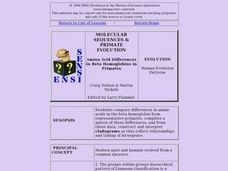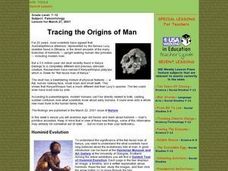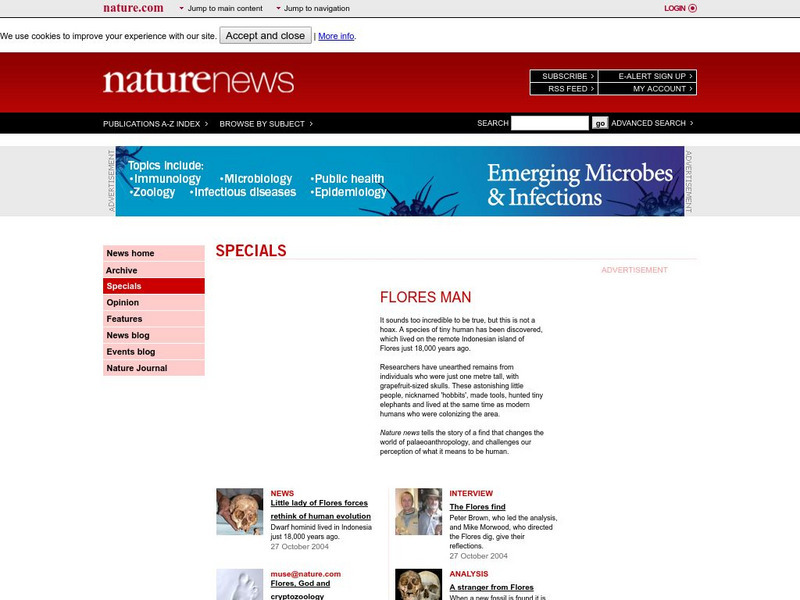Curated OER
What is the Evidence for Evolution?
Learners identify one object that would tell the story of their lives. In groups, they determine what can and cannot be told from objects left behind. After watching a video, they compare and contrast chicken bones to human bones. To...
Curated OER
Introduction to Adaptation
Tenth graders observe collections of specimens and discuss their answers to provided questions. They explore common ancestry, homology, analogy, adaptive radiation, and evolution, while formulating creative answers based on their...
Curated OER
How Did Humans Evolve?
Learners are introduced to four important fossil finds: the First Family, the Hadar Skull, Lucy, and the Laetoli Footprints. They explore how scientists interpret fossils to try to better comprehend how humans evolved. This activity...
Curated OER
Molecular Sequences & Primate Evolution: Amino Acids, Hemoglobins in Evolution
Students compare differences in amino acids in the beta hemoglobin from representative primates, complete a matrix of those differences, and from these data, construct and interpret cladograms as they reflect relationships and timing of...
Curated OER
Hominid Series
Young scholars are introduced to the human stages of evolution. They complete a series of lessons on identifying the cranial structure for various hominids, understanding the timeline involved in human evolution and investigating ancient...
Curated OER
Hominoid Skull Comparison
Students are provided with evidence used to support evolutionary theory. They are introduced to classification by using primates as an example. Students read article related to Hominoid Skull Comparison and write a summary about the...
Howard Hughes Medical Institute
Explore Your Inner Animals
Human bodies prove evolution thanks to our genes, bones, and more. Learning about specific body parts and how they evolved from other species helps individuals better understand the transition species that helped us become who we are today.
Curated OER
Tracing the Origins of Man
Students discuss Hominid evolution through various websites and other resources. They examine online fossil skulls, discuss the use of tools by ancient man, and look for examples of sophisticated tools built by man.
Curated OER
Human Ancestry
In this human ancestry worksheet, learners will answer questions about hominids, "Lucy", and the emergence of modern humans. Then students will compare the characteristics of Neanderthals and Cro-Magnons. This worksheet has four short...
Educa Madrid
Prehistory
Images of the Atapuerca Caves, the cave paintings at Altamira, and a Neanderthal skull found at Forbes' Quarry on Gibraltar serve to introduce kids to prehistoric sites in Spain. Designed to support a study of prehistoric Spain, the...
Curated OER
The Earliest Primates
In this early primate worksheet, students will read information about the fossil evidence of the earliest primates. Students will complete 3 short answer questions based on their reading.
Curated OER
The Chromosome Connection
Learners evaluate the degree of chromosome similarity and difference between humans and apes. Students infer about the relationship between a human and ape based on similarities found.
Curated OER
A Little Horse Sense
How have horses evolved over time? How do horse skulls reveal this evolution? How have the roles horses play changed over time? What kind of social structure do horse herds have? How should wild horse populations be managed? To find the...
Curated OER
Hominoid Cranium Comparison
Learners describe, measure and compare cranial casts from contemporary apes (chimpanzees and gorillas, typically), modern humans and fossil "hominids" (erect and bipedal forms evolutionarily separated from apes).
Curated OER
Activity: Bird Beak Buffet
Students study the functions of bird beaks. In this animal evolution lesson, students compare and contrast different types of bird beaks focusing on how the beaks are adapted to the foods the birds eat. Students record and graph their...
Curated OER
Pause for Thought
Students discover the customs of Ramadan. In this Muslim beliefs lesson plan, students research the listed Web sites about the history of Ramadan, the evolution of calendars, and the separation of church and state.
Curated OER
Dolphin Brains
Students listen to an interview with Lori Marino regarding the development of dolphin brains and read a summarizing text. They conduct further research and participate in class discussion.
Curated OER
Primary Source: Lucy
In this primary source worksheet, students read a selection about Lucy, a skeleton discovered in 1974, then complete a set of 4 document-based questions.
Curated OER
Critical Reading: Intelligence Augmentation
In this critical reading instructional activity, students read a short passage regarding intelligence augmentation and then answer five questions based on the reading.
Curated OER
ESL: Journalism Article Comprehension
In this ESL comprehension worksheet, students read a passage, then complete a variety of warm-up and pre/post reading activities. Homework suggestions are included.
Scientific American
Scientific American: Oldest Member of the Human Family
This article, published by Scientific American (July 11, 2002), highlights the discovery of a nearly complete skull of the oldest and most primitive member of the human family known yet. This fossil, found in central Africa, contains a...
Science Daily
Science Daily: The Oldest Homo Sapiens
The oldest fossils of modern humans (Homo Sapiens) found near Omo Kibish, Ethiopia, have been identified as being approximately 196,000 years old. This article points out the amazing significance of these findings.
Nature Research
News @ Nature: Flores Man
Site from News @ Nature provides the story of the remarkable discovery on the Island of Flores, Flores Man. See a great picture of the skull and read explanations and reflections from the leading palaeoanthropologists on the dig.
Talk Origins Archive
Talk Origins: The Hominid Species
Talk Origins gives a broad description of the types of Hominid species, and then gives a description of each species. Includes the specific characteristics of each, and explains the differences between the species.

























